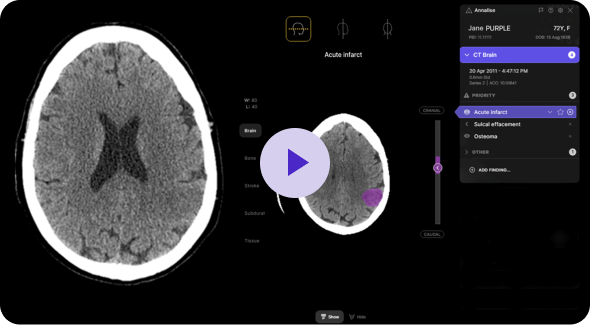Authored by: Mark Wilson, Director Customer Success, Annalise.ai
You’ve chosen a radiology AI solution and are ready to get it up and running at your NHS trust. So, what happens next? Whether you’re deploying the solution for research purposes or for widespread clinical use across all the Trust hospitals, it’s crucial to develop a deployment plan before moving forward.
Following these six steps can help ensure your chosen solution is integrated successfully and delivers maximal value for many years.
1. Discovery and Design
Before launching in, it’s important to understand your key goals and objectives or what problem you are trying to overcome. How are you planning to implement AI into your clinical workflow and ideally what does success look like? Our team ensures that any new implementation starts with a deep discovery process, recognising that every customer has a unique approach.
Typically, NHS Trusts deploy AI technologies such as the Annalise Enterprise solutions for:
- Disease detection and treatment
- Decision support for differential diagnosis
- Risk stratification
- Manage incidental findings
- Reducing ‘never events’
- System Efficiency
- Optimisation of care pathways
- Optimising resource allocation
- Reducing treatment and outsourcing costs
- Disease monitoring and prevention
Following the discovery stage, our team will look to design the optimal technical and clinical solution for your use case. We also take success seriously, ensuring all parties are aligned on what success factors are applicable and how we will measure those agreed KPIs.
2. Investing in Change Management
We understand that the people side of change is often complex, but also critical to the long-term success of any clinical AI adoption project.
At Annalise, we know adoption goes beyond just the technical integration and training. It’s crucial that Clinicians using our solutions understand the broader change process and are equipped to adjust their workflow habits and behaviours.
Unfortunately, organisational change often fails because those individuals impacted by the change don’t understand it’s importance or how to successfully navigate the change. When organisations invest in managing change well, their AI projects are much more likely to exceed expectations and deliver on their goals.
Our Customer Success team will advise on managing change effectively and guide you through various activities to make sure everyone is aware of the change, knows how to adapt, and how to sustain the new workflow practices longer term.
3. Communicate, communicate, communicate
Effective communication is essential when implementing any change. Organisations with an enterprise-wide strategy and leaders who communicate a clear vision are 1.7 times more likely to achieve successful outcomes**.
It’s crucial to ensure that clinicians affected by the change understand the “What” and the “Why.” Why did our Trust or Network invest in this AI solution, and what problem are we aiming to solve with it? Why now? Clarifying the benefits and how this change will improve or alter the clinical user’s experience is vital at this stage.
When communicating, it’s important to employ various methods, including face-to-face communication, even in virtual settings. Additionally, the person who delivers the message is as significant as the content itself. Both senior leaders and direct supervisors should play a role in communicating the rationale for the change.
4. Assemble your champions
In addition to these activities, it is critical to assemble a coalition of local champions to help drive change internally. These champions would include clinicians who have a keen interest in AI along with some prior exposure to, or some understanding of, AI. They can play a crucial role in overcoming resistance from potential detractors and fostering trust among their peers by facilitating information sharing and offering mentorship and support.
Make sure you have advocates at every level including:
- C-suite executives & management across sites
- Clinical chairs/department heads
- Clinicians including Radiologists & Reporting Radiographers
- IT and technical support teams.
5. Installation and deployment.
Technical installation and deployment is a critical next step. Depending on the architecture within your Trust, this will probably involve installing new components and integrating the AI with existing third-party systems such as RIS/PACS.
Your AI solution provider should work closely with your IT team and departmental contacts to first undertake a deep technical discovery to mitigate against any technical issues during the installation process.
Ongoing communication, a collaborative approach and a regular project cadence will ensure the project continues to move forward, any issues are identified early and resolved accordingly.
6. Driving longer term adoption
As your clinical teams continue to use the product, it’s important to keep evaluating its performance. A regular monitoring schedule, underpinned by robust data, can help you continue to rapidly identify and address any technical issues.
Continue collecting user feedback and post-market surveillance data based on the success metrics you defined before choosing the solution. This might include measures of:
- clinical outcome KPIs
- AI model performance (such as rates of false positive and false negatives)
- software versus radiologist performance
- clinician feedback about the solution.
Ongoing education & customisation will continue to support progress towards AI maturity within your Trust. Stay in contact with your vendor, who can provide you with updates and help ensure you continue to get maximum benefit from your solution.
At Annalise.ai, we provide end-to-end implementation and change management support for all our customers. From the moment you choose our solution to the months and years following, we’re dedicated to ensuring your deployment continues to be successful.
**Becoming an AI-fueled organization Deloitte’s State of AI in the Enterprise, 4th Edition
